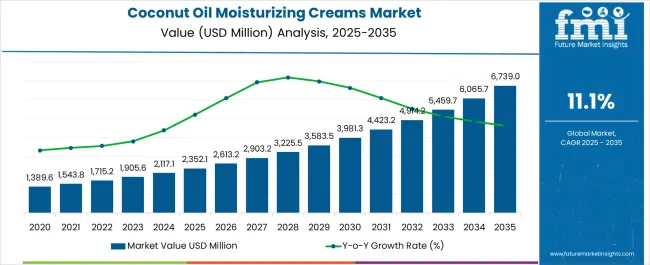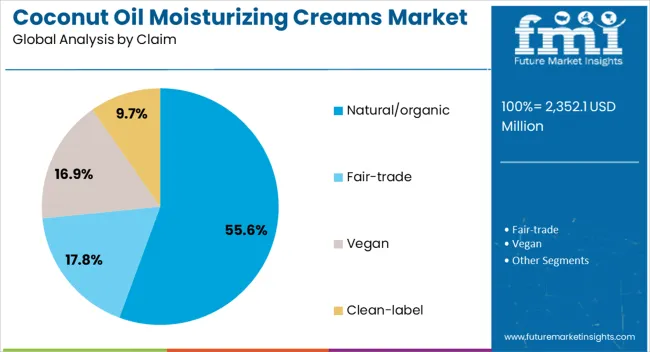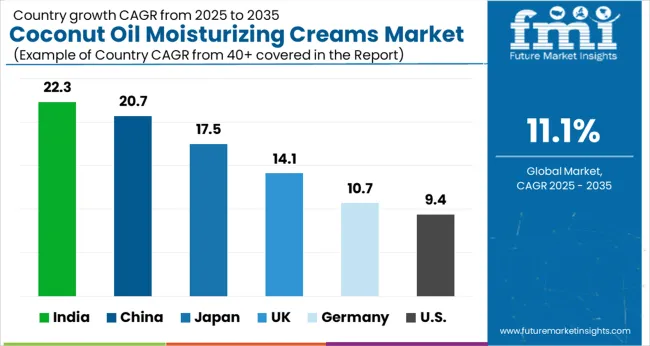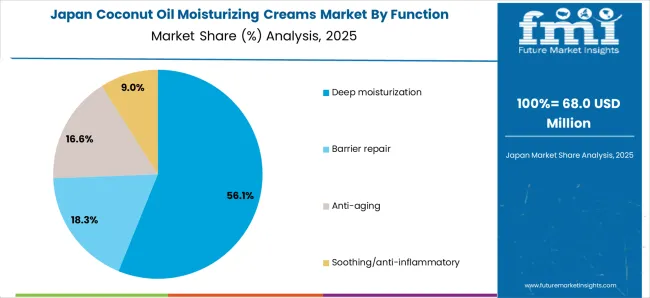The global coconut oil moisturizing creams market is projected to grow from USD 2,352.1 million in 2025 to approximately USD 6,739 million by 2035, recording an absolute increase of USD 4,430.0 million over the forecast period. This translates into a total growth of 190.7%, with the market forecast to expand at a compound annual growth rate (CAGR) of 11.1% between 2025 and 2035. The overall market size is expected to grow by nearly 2.9X during the same period, supported by the rising demand for natural and organic skincare products and increasing consumer awareness about the benefits of coconut oil in personal care applications.

Between 2025 and 2030, the Coconut Oil Moisturizing Creams market is projected to expand from USD 2,352.1 million to USD 3,985.5 million, resulting in a value increase of USD 1,662.3 million, which represents 37.5% of the total forecast growth for the decade. This phase of growth will be shaped by rising penetration of natural and organic beauty products, increasing consumer preference for clean-label formulations, and growing awareness about the moisturizing benefits of coconut oil. Service providers are expanding their product portfolios to address the growing demand for sustainable and environmentally-friendly personal care solutions.
| Metric | Value |
|---|---|
| Estimated Size (2025E) | USD 2,352.1 million |
| Projected Value (2035F) | USD 6,739 million |
| CAGR (2025-2035) | 11.1% |
From 2030 to 2035, the market is forecast to grow from USD 3,985.5 million to USD 6,739 million, adding another USD 2,767.7 million, which constitutes 62.5% of the overall ten-year expansion. This period is expected to be characterized by advancement of organic formulation technologies, integration of sustainable packaging solutions, and development of specialized coconut oil-based products across different consumer segments. The growing adoption of vegan and cruelty-free personal care products will drive demand for more natural coconut oil moisturizing formulations.
Between 2020 and 2025, the Coconut Oil Moisturizing Creams market experienced steady expansion, driven by increasing consumer awareness of natural ingredients and the rising popularity of clean beauty trends. The market developed as consumers became increasingly conscious of product ingredients and beauty brands recognized the potential of coconut oil-based formulations to meet growing demand for natural, effective moisturizing solutions.
Market expansion is being supported by the increasing consumer preference for natural and organic skincare products that offer effective moisturizing benefits without synthetic chemicals. Modern consumers seek products with recognizable, plant-based ingredients that align with their values of sustainability and wellness, driving demand for coconut oil-based formulations that provide deep hydration and nourishment for various skin types.
The growing awareness of coconut oil's beneficial properties, including its antimicrobial, anti-inflammatory, and deeply moisturizing characteristics, is enabling broader market adoption across different consumer demographics. Beauty brands are increasingly incorporating coconut oil into their formulations to meet consumer demand for clean, natural products that deliver proven results while supporting sustainable sourcing practices.
The market is segmented by function, product type, claim, and channel. By function, the market is divided into deep moisturization, barrier repair, anti-aging, and soothing/anti-inflammatory. Based on product type, the market is categorized into creams/lotions, balms, body butters, serums, and others. In terms of claim, the market is segmented into natural/organic, fair-trade, vegan, clean-label, and others. By channel, the market is classified into mass retail, e-commerce, pharmacies, and specialty organic stores. Regionally, the market is divided into North America, Europe, East Asia, South Asia & Pacific, Latin America, and Middle East & Africa.

Deep moisturization is projected to account for 56.6% of the market in 2025, valued at USD 1,301.4 million, establishing its position as the leading functional category in the global marketplace. This dominant market share is fundamentally supported by coconut oil's exceptional moisturizing properties and its ability to penetrate deeply into skin layers, providing long-lasting hydration and nourishment.
The preference for deep moisturization stems from coconut oil's unique molecular structure, which allows for superior skin penetration and moisture retention compared to conventional moisturizing agents. This functionality addresses the primary consumer need for effective hydration solutions that provide lasting results, particularly for dry and sensitive skin types that require intensive moisture therapy.
The market leadership of deep moisturization is further reinforced by increasing consumer awareness of coconut oil's natural emollient properties and its effectiveness in treating various skin conditions including eczema, dermatitis, and general skin dryness. The segment benefits from extensive research validating coconut oil's moisturizing benefits and its compatibility with different skin types, creating consumer confidence in products focused on deep hydration delivery.

Creams/lotions are expected to represent 52.5% of coconut oil moisturizing products demand in 2025, valued at USD 1,208.1 million, establishing their dominance in the global market landscape. This commanding market position reflects consumer preference for familiar, easy-to-use formulations that provide effective moisturizing benefits in convenient packaging formats.
The creams/lotions segment benefits from versatile application methods and formulation flexibility that allows manufacturers to create products suitable for different skin types, body areas, and usage occasions. These products can be formulated with varying concentrations of coconut oil and complementary ingredients to address specific skin concerns while maintaining the lightweight, non-greasy texture preferred by most consumers.
The segment's growth is further supported by established distribution channels, consumer familiarity with cream and lotion formats, and the ability to incorporate coconut oil into existing product lines without significant reformulation challenges. The versatility of creams/lotions enables brands to target multiple consumer segments while leveraging coconut oil's beneficial properties across different price points and market positioning strategies.

Natural/organic claims are projected to contribute 55.6% of the coconut oil moisturizing creams market in 2025, valued at USD 1,277.8 million, representing the preferred positioning for coconut oil-based skincare products. This claim category aligns perfectly with coconut oil's inherent natural origins and supports consumer preferences for clean, environmentally-conscious beauty products.
The competitive advantage of natural/organic positioning lies in its ability to communicate product authenticity, safety, and environmental responsibility to increasingly conscious consumers. This positioning resonates particularly well with coconut oil products, as the ingredient's natural extraction process and traditional use in skincare support credible natural and organic claims.
Natural/organic claims enable brands to command premium pricing while building consumer trust through transparent ingredient communication and sustainable sourcing practices. The segment supports long-term brand loyalty and enables companies to align with growing consumer values around health, wellness, and environmental stewardship in personal care product selection.
The market is advancing steadily due to increasing consumer awareness of natural ingredients and growing demand for clean beauty products. However, the market faces challenges including potential allergenicity concerns for sensitive individuals, supply chain fluctuations affecting coconut oil availability, and competition from alternative natural oils. Quality standardization of coconut oil sources and sustainable sourcing practices continue to influence market development patterns.
The growing consumer shift toward clean beauty products with recognizable, natural ingredients is driving significant demand for coconut oil-based moisturizing formulations. Consumers are increasingly scrutinizing product labels and seeking alternatives to synthetic chemicals, creating opportunities for brands to leverage coconut oil's natural properties and proven moisturizing benefits in their product portfolios.
Modern coconut oil moisturizing cream manufacturers are incorporating comprehensive sustainability initiatives including fair-trade sourcing, organic certification, and environmentally-responsible packaging to meet growing consumer expectations for ethical beauty products. Integration of transparent supply chain practices and social responsibility initiatives provides competitive advantages and supports premium product positioning.

| Country | CAGR (2025 to 2035) |
|---|---|
| India | 22.3% |
| China | 20.7% |
| Japan | 17.5% |
| UK | 14.1% |
| Germany | 10.7% |
| USA | 9.4% |
The coconut oil moisturizing creams market is growing rapidly across key regions, with India leading at a 22.3% CAGR through 2035, driven by traditional use of coconut oil in skincare, rising disposable income, and increasing adoption of premium personal care products. China follows at 20.7%, supported by growing awareness of natural beauty products and expanding e-commerce infrastructure. Japan grows at 17.5%, emphasizing quality natural ingredients and premium skincare demand. The UK records 14.1% growth with focus on organic and sustainable beauty trends. Germany shows 10.7% growth driven by quality and natural product preferences. The USA demonstrates steady 9.4% growth with established natural beauty market adoption and diverse distribution channels.
Revenue from coconut oil moisturizing creams in India is projected to exhibit the highest growth rate with a CAGR of 22.3% through 2035, driven by deep cultural familiarity with coconut oil benefits, rapidly expanding middle class, and increasing preference for natural personal care products. The country's traditional use of coconut oil in skincare routines, combined with modern formulation techniques and growing disposable income, creates an ideal environment for market expansion across urban and semi-urban markets.
Revenue from coconut oil moisturizing creams in China is expanding at a CAGR of 20.7%, supported by increasing consumer interest in natural and organic beauty products, sophisticated e-commerce infrastructure, and growing awareness of coconut oil's skincare benefits. The country's rapidly evolving beauty market and consumer willingness to experiment with international natural ingredients create favorable conditions for coconut oil-based product adoption.

Revenue from coconut oil moisturizing creams in Japan is growing at a CAGR of 17.5%, driven by consumer appreciation for high-quality natural ingredients, sophisticated skincare routines, and willingness to invest in premium personal care products. Japanese consumers demonstrate strong preference for products with proven benefits and clean formulations, supporting demand for well-formulated coconut oil moisturizing solutions.
Demand for coconut oil moisturizing creams in the UK is projected to grow at a CAGR of 14.1%, supported by strong consumer interest in organic and sustainable beauty products, established natural beauty market, and increasing awareness of coconut oil's skincare benefits. British consumers demonstrate growing preference for clean beauty products with transparent ingredient lists and ethical sourcing practices.
Demand for coconut oil moisturizing creams in Germany is expanding at a CAGR of 10.7%, driven by consumer preference for high-quality natural products, established organic personal care market, and stringent quality standards. German consumers value product efficacy, ingredient transparency, and sustainable practices, creating demand for well-formulated coconut oil moisturizing solutions that meet comprehensive quality requirements.
Demand for coconut oil moisturizing creams in the USA is growing at a CAGR of 9.4%, characterized by diverse consumer segments, established natural beauty market, and steady adoption of coconut oil-based skincare products. The American market demonstrates strong interest in natural beauty innovations while maintaining focus on product accessibility, proven results, and diverse formulation options that address different consumer needs and preferences.
The coconut oil moisturizing creams market is characterized by competition among established personal care companies, natural beauty specialists, and emerging clean beauty brands. Companies are investing in sustainable sourcing practices, product innovation, quality assurance, and comprehensive marketing strategies to deliver effective, appealing, and responsibly-produced coconut oil-based moisturizing solutions. Strategic partnerships, ingredient sourcing optimization, and consumer education initiatives are central to strengthening product portfolios and market presence.
Palmer's leads the market with an 8.3% global value share in 2025, focusing on heritage formulations and accessible pricing strategies that leverage traditional coconut oil benefits. The Body Shop emphasizes ethical sourcing and sustainability messaging in their coconut oil product lines. OGX provides salon-quality formulations with coconut oil integration across multiple product categories. Herbivore Botanicals focuses on clean, minimalist formulations that highlight coconut oil purity and effectiveness.
L'Oréal leverages advanced formulation technologies to optimize coconut oil benefits in mainstream product lines. Unilever offers comprehensive coconut oil moisturizing solutions across multiple brand portfolios and price points. Aveeno integrates coconut oil into dermatologist-recommended formulations for sensitive skin applications. SheaMoisture emphasizes natural heritage and community commerce in coconut oil product development. Yes To provides affordable, natural coconut oil moisturizing options for mass market consumers. Kopari Beauty specializes exclusively in coconut oil-based beauty and personal care products with premium positioning.
| Items | Values |
|---|---|
| Quantitative Units (2025) | USD 2,352.1 million |
| Function | Deep moisturization, Barrier repair, Anti-aging, Soothing/anti-inflammatory |
| Product Type | Creams/lotions, Balms, Body butters, Serums, Others |
| Claim | Natural/organic, Fair-trade, Vegan, Clean-label, Others |
| Channel | Mass retail, E-commerce, Pharmacies, Specialty organic stores |
| Regions Covered | North America, Europe, East Asia, South Asia & Pacific, Latin America, Middle East & Africa |
| Countries Covered | United States, Canada, United Kingdom, Germany, France, China, Japan, South Korea, India, Brazil, Australia and 40+ countries |
| Key Companies Profiled | Palmer's, The Body Shop, OGX, Herbivore Botanicals, L'Oréal, Unilever, Aveeno, SheaMoisture, Yes To, and Kopari Beauty |
The global coconut oil moisturizing creams market is estimated to be valued at USD 2,352.1 million in 2025.
The market size for the coconut oil moisturizing creams market is projected to reach USD 6,739.0 million by 2035.
The coconut oil moisturizing creams market is expected to grow at a 11.1% CAGR between 2025 and 2035.
The key product types in coconut oil moisturizing creams market are deep moisturization, barrier repair, anti-aging and soothing/anti-inflammatory.
In terms of product type, creams/lotions segment to command 52.5% share in the coconut oil moisturizing creams market in 2025.






Full Research Suite comprises of:
Market outlook & trends analysis
Interviews & case studies
Strategic recommendations
Vendor profiles & capabilities analysis
5-year forecasts
8 regions and 60+ country-level data splits
Market segment data splits
12 months of continuous data updates
DELIVERED AS:
PDF EXCEL ONLINE
Coconut Derived Surfactants Market Size and Share Forecast Outlook 2025 to 2035
Coconut Water Cosmetics Market Analysis - Size and Share Forecast Outlook 2025 to 2035
Coconut Water-Based Formulas Market Analysis - Size and Share Forecast Outlook 2025 to 2035
Coconut Milk Powder Market Size and Share Forecast Outlook 2025 to 2035
Coconut Water Market Size, Growth, and Forecast 2025 to 2035
Coconut Milk Products Market Trends – Size, Demand & Forecast 2025-2035
Coconut Milk Market Analysis – Size, Share & Forecast Outlook 2025 to 2035
Coconut Butter Market Analysis by End-use Application Sales Channel Through 2025 to 2035
Coconut Sugar Market By Form, Nature, Application and Region - Forecast from 2025 to 2035
Coconut Flour Market Analysis by End-Use, Application, Product Form, Technology, Nature, and Region from 2025 to 2035
Coconut Wraps Market Outlook – Growth, Demand & Forecast 2025 to 2035
Competitive Overview of Coconut Syrup Industry Share
Coconut Cream Market – Growth, Demand & Dairy Alternatives Trends
Coconut-Free Skincare Market Growth – Size, Trends & Forecast 2024-2034
Coconut Fatty Acids Market
Coconut Oil Market Insights - Growing Applications & Industry Expansion 2025 to 2035
Complex Coconut Sugar Market Size and Share Forecast Outlook 2025 to 2035
Analyzing Cooking Coconut Milk Market Share & Industry Leaders
Cooking Coconut Milk Market – Growth, Demand & Culinary Applications
Packaged Coconut Water Market Size and Share Forecast Outlook 2025 to 2035

Thank you!
You will receive an email from our Business Development Manager. Please be sure to check your SPAM/JUNK folder too.
Chat With
MaRIA